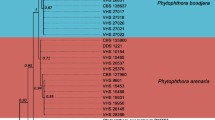Abstract
A Phytophthora species was isolated from blackened leaves and stems of infected Cymbidium plants. Cultural characters did not fit descriptions of any known Phytophthora species. It was concluded that a new Phytophthora species, described here as Ph. multivesiculata is the causal agent. Isozyme data support this claim.
Similar content being viewed by others
References
Burnett HC (1974) Black rot of orchids. In: Orchid Diseases, pp 8-9 (Bulletin, Florida department of agricultural and consumer services, no 10)
Chen JS and Hsieh SPY (1978) Phytophthorablack rot of Phalaneopsisin Taiwan. Pl Prot Bull Taiwan 20: 161-170
De Cock AWAM, Neuvel A, Bahnweg G, De Cock JCJM and Prell HH (1992) A comparison of morphology, pathogenicity and restriction fragment patterns of mitochondrial DNA among isolates of Phytophthora porriFoister. Neth J Plant Pathol 98: 277-289
Duff JD (1993) Orchid Diseases of the Northern Territory. Agnote (Darwin) N 568: 3
Gams W, van der Aa HA, van der Plaats-Niterink AJ, Samson RA and Stalpers JA (1987) CBS course of Mycology, CBS, Baarn, The Netherlands
Hall G (1989) Unusual or interesting records of plant pathogenic Oomycetes. Plant Pathology 38: 604-611
Ilieva, E, Arulappan, FX and Pieters R (1995) Phytophthoraroot and crown rot of raspberry in Bulgaria. Europ J Plant Pathol 101: 623-626
Karakaya A, Gray FA and Koch DW(1995) Characterization of two Phytophthoraspp. isolated from Kale and Tyfon. Mycotaxon v. LVI: 483-490
Kröber H, (1985) Erfahrungen mit Phytophthorade Bary und PythiumPringsheim. Mitteilungen aus der biologischen Bundesanstalt für Land-und Forstwirtschaft, Heft 225, Berlin-Dahlem, 175 pp.
Nygaard SL, Elliott CK, SJ Cannon and Maxwell DP (1989) Isozyme variability among isolates of Phytophthora megasperma. Phytopathology 79: 773-780
Oudemans P and Coffey MD (1991a) Isozyme comparison within and among worldwide sources of three morphologically distinct species of Phytophthora. Mycol Res 95: 19-30
Oudemans P and Coffey MD (1991b) A revised systematics of twelve papillate Phytophthoraspecies based on isozyme analysis. Mycol Res 95: 1025-1046
Richardson BJ, Baverstock PR and Adams M (1986). Allozyme electrophoresis p. 23 Academic Press, New York
Stamps GJ, Waterhouse GM, Newhook FJ and Hall GS (1990). Revised tabular key to the species of Phytophthora. Mycol Pap 162, 28pp.
Uchida JY (1994) Diseases of Orchids in Hawaii. Plant Disease 78: 220-224
Waterhouse GM(1963) Key to the species of Phytophthorade Bary. Mycol Pap 92, 22pp.
Wey GC (1988) Occurrence and investigation of important diseases on Phalaenopsisin Taiwan. Reports of the Taiwan Sugar Research Institute 122: 31-41
Author information
Authors and Affiliations
Rights and permissions
About this article
Cite this article
Ilieva, E., Man in 't Veld, W., Veenbaas-Rijks, W. et al. Phytophthora multivesiculata, a new species causing rot in Cymbidium. European Journal of Plant Pathology 104, 677–684 (1998). https://doi.org/10.1023/A:1008628402399
Issue Date:
DOI: https://doi.org/10.1023/A:1008628402399




